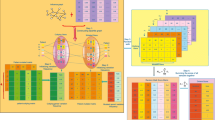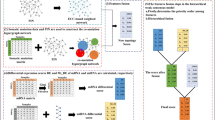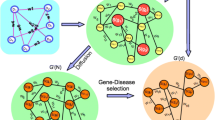Abstract
With the constant update of large-scale sequencing data and the continuous improvement of cancer genomics data, such as International Cancer Genome Consortium (ICGC) and The Cancer Genome Atlas (TCGA), it gains increasing importance to detect the functional high-frequency mutation gene set in cells that causes cancer in the field of medicine. In this study, we propose a new recognition method of driver modules, named ECSWalk to solve the issue of mutated gene heterogeneity and improve the accuracy of driver modules detection, based on human protein–protein interaction networks and pan-cancer somatic mutation data. This study first utilizes high mutual exclusivity and high coverage between mutation genes and topological structure similarity of the nodes in complex networks to calculate interaction weights between genes. Second, the method of random walk with restart is utilized to construct a weighted directed network, and the strong connectivity principle of the directed graph is utilized to create the initial candidate modules with a certain number of genes. Finally, the large modules in the candidate modules are split using induced subgraph method, and the small modules are expanded using a greedy strategy to obtain the optimal driver modules. This method is applied to TCGA pan-cancer data and the experimental results show that ECSWalk can detect driver modules more effectively and accurately, and can identify new candidate gene sets with higher biological relevance and statistical significance than MEXCOWalk and HotNet2. Thus, ECSWalk is of theoretical implication and practical value for cancer diagnosis, treatment and drug targets.
Graphic Abstract








Similar content being viewed by others
Data Availability
The data and codes we used can be download from https://github.com/HaoWuLab-Bioinformatics/wu-group.
Abbreviations
- ICGC:
-
International cancer genome consortium.
- TCGA:
-
The cancer genome atlas.
- ECSWalk:
-
A carcinogenic driver module detection method based on a network model.
- MEXCOWalk:
-
Mutual exclusion and coverage based random walk to detect cancer modules.
- HotNet2:
-
An algorithm for finding significantly altered subnetworks in a large gene interaction network.
- KL:
-
Kullback–Leibler, A method of describing the difference between two probability distributions.
- JS:
-
Jensen–Shannon, an improved method based on KL divergence.
- PPI:
-
Protein–protein interaction.
- HINT+HI2012:
-
A combination of high-quality protein–protein interactions from HINT and the recent HI2012 set of protein–protein interactions.
- DAVID:
-
The database for annotation, visualization and integrated discovery.
- SCC:
-
Strongly connected component of the directed graph.
- TP:
-
True positive
- FP:
-
False positive
- TN:
-
True negative
- FN:
-
False negative
- GBM:
-
Glioblastoma multiforme
- BLCA:
-
Bladder urothelial carcinoma
- UCEC:
-
Uterine corpus endometrial carcinoma
- NSCLC:
-
Non-small-cell lung cancer
- PAAD:
-
Pancreatic adenocarcinoma
- CML:
-
Chronic myelocytic leukemia
- LAML:
-
Acute myeloid leukemia
- COAD:
-
Colon adenocarcinoma
References
Spaans VM, Trietsch MD, Crobach S, Stelloo E, Kremer D, Osse EM, Haar NT, van Eijk R, Muller S, van Wezel T, Trimbos JB, Bosse T, Smit VT, Fleuren GJ (2014) Designing a high-throughput somatic mutation profiling panel specifically for gynaecological cancers. Plos One 9:e93451. https://doi.org/10.1371/journal.pone.0093451
Yu XT, Zeng T, Li GJ (2015) Integrative enrichment analysis: a new computational method to detect dysregulated pathways in heterogeneous samples. BMC Genomics 16:918. https://doi.org/10.1186/s12864-015-2188-7
Zhang JH, Wu LY, Zhang SX, Zhang SH (2014) Discovery of co-occurring driver pathways in cancer. BMC Bioinformatics 15:1–14. https://doi.org/10.1186/1471-2105-15-271
Zhao JF, Zhang SH, Wu LY, Zhang XS (2012) Efficient methods for identifying mutated driver pathways in cancer. Bioinformatics 28:2940. https://doi.org/10.1093/bioinformatics/bts564
Greenman C, Stephens P, Smith R, Dalgliesh GL, Hunter C, Gand Bignell, Davies H, Teague J, Butler A, Stevens C, Edkins S, O’Meara S, Vastrik I, Schmidt EE, Avis T, Barthorpe S, Bhamra G, Buck G, Choudhury B, Clements J, Cole J, Dicks E, Forbes S, Gray K, Halliday K, Harrison R, Hills K, Hinton J, Jenkinson A, Jones D, Menzies A, Mironenko T, Perry J, Raine K (2007) Patterns of somatic mutation in human cancer genomes. Nature 446:153–158. https://doi.org/10.1038/nature05610
Vandin F, Upfal E, Raphael BJ (2012) De novo discovery of mutated driver pathways in cancer. Genome Res 22:175–181. https://doi.org/10.1007/978-3-642-20036-6_44
Leiserson MDM, Blokh D, Sharan RJ, Raphael B (2013) Simultaneous identification of multiple driver pathways in cancer. PLOS Computational Biology 9:e1003054. https://doi.org/10.1371/journal.pcbi.1003054
Hou JP, Ma JB (2014) Dawnrank: discovering personalized driver genes in cancer. Genome Med 6:5. https://doi.org/10.1186/s13073-014-0056-8
Udager AM, Rolland DCM, McHugh JB, Betz BL, Murga-Zamalloa C, Carey TE, Marentette LJ, Hermsen MA, DuRoss KE, Lim MS, Elenitoba-Johnson KSJ, Brown NA (2015) High-frequency targetable EGFR mutations in sinonasal squamous cell carcinomas arising from inverted sinonasal papilloma. Cancer Res 75:2600–2606. https://doi.org/10.1158/0008-5472.can-15-0340
Gonzalez D, Martinez P, Wade R, Hockley S, Oscier D, Matutes E, Dearden CE, Richards SM, Catovsky D, Morgan GJ (2016) Mutational status of the tp53 gene as a predictor of response and survival in patients with chronic lymphocytic leukemia: results from the lrf cll4 trial. J Clin Oncol 29:2223–2229. https://doi.org/10.1200/JCO.2010.32.0838
Zhong SY, Zhou SL, Li AQ, Lv H, Li M, Tang SX, Xu XL, Shui RH, Yang WT (2021) High frequency of PIK3CA and TERT promoter mutations in fibromatosis-like spindle cell carcinomas. J Clin Pathol https://doi.org/10.1136/JCLINPATH-2020-207071
Srihari S, Ragan MA (2013) Systematic tracking of dysregulated modules identifies novel genes in cancer. Bioinformatics 29:1553–1561. https://doi.org/10.1093/bioinformatics/btt191
Wu H, Gao L, Dong JH, Yang XF (2014) Detecting overlapping protein complexes by rough-fuzzy clustering in protein-protein interaction networks. Plos One 9:e91856. https://doi.org/10.1371/journal.pone.0091856
Wu H (2018) Algorithm for Detecting Driver Pathways in Cancer Based on Mutated Gene Networks. Chinese J Comput 41(1400–1414), https://doi.org/10.11897/SP.J.1016.2018.01400
Miller CA, Settle SH, Sulman EP, Aldape KD, Milosavljevic A (2011) Discovering functional modules by identifying recurrent and mutually exclusive mutational patterns in tumors. BMC Med Genomics 4:34. https://doi.org/10.1186/1755-8794-4-34
Kim YA, Cho DY, Dao P, Przytycka TM (2015) Memcover: integrated analysis of mutual exclusivity and functional network reveals dysregulated pathways across multiple cancer types. Bioinformatics 31:284–292. https://doi.org/10.1093/bioinformatics/btv247
Leiserson MDM, Vandin F, Wu HT, Dobson JR, Eldridge JV, Thomas JL, Papoutsaki A, Kim YH, Niu BF, McLellan M, Lawrence MS, Gonzalez-Perez A, Tamborero D, Cheng YW, Ryslik GA, Lopez-Bigas N, Getz G, Ding L, Raphael BJ (2015) Pan-cancer network analysis identifies combinations of rare somatic mutations across pathways and protein complexes. Nat Genet 47:106–114. https://doi.org/10.1038/ng.3168
Reyna MA, Leiserson MDM, Raphael BJ (2018) Hierarchical hotnet: identifying hierarchies of altered subnetworks. Bioinformatics 34:972–980. https://doi.org/10.1093/bioinformatics/bty613
Rafsan A, Ilyes B, Cesim E, Evis H, Hilal K (2019) Mexcowalk: mutual exclusion and coverage based random walk to identify cancer modules. Bioinformatics 36:872–879. https://doi.org/10.1101/547653
Wu H, Gao L, Li F, Yang XF, Kasabov N (2015) Identifying overlapping mutated driver pathways by constructing gene networks in cancer. Bioinformatics 16:S3. https://doi.org/10.1186/1471-2105-16-S5-S3
Nepusz T, Yu H, Paccanaro A (2012) Detecting overlapping protein complexes in protein–protein interaction networks. Nat Methods 9:471–472. https://doi.org/10.1038/nmeth.1938
Guo MZ, Wang SM, Liu XY, Tian Z (2017) Algorithm for predicting the associations between MiRNAs and diseases. J Softw 28:3094–3102. https://doi.org/10.13328/j.cnki.jos.005351
Tang DM, Zhu QX, Yang F, Chen K (2011) Efficient cluster analysis method for protein sequences. J Softw 22:1827–1837. https://doi.org/10.3724/sp.j.1001.2011.03848
Hou YX, Duan L, Li L, Lu L, Tang CJ (2018) Search of genes with similar phenotype based on disease information network. J Softw 29(721–733):10.13328/j.cnki.jos.005445
Zhang Q, Li M, Deng Y (2016) A new structure entropy of complex networks based on tsallis nonextensive statistical mechanics. Int J Modern Phys C 27:440–450. https://doi.org/10.1142/S0129183116501187
Hofree M, Shen JP, Carte H, Gross A, Ideker T (2013) Network-based stratification of tumor mutations. Nat Methods 10:1108–1115. https://doi.org/10.1038/nmeth.2651
Li F, Gao L, Wang B (2020) Detection of driver modules with rarely mutated genes in cancers. IEEE/ACM Trans Comput Biol Bioinform 17:390–401. https://doi.org/10.1109/TCBB.2018.2846262
Wang BQ, Wang M, Li XP, Yang M, Liu L (2020) Variations in the Wnt/\(\beta\)-Catenin Pathway Key Genes as Predictors of Cervical Cancer Susceptibility. Pharmacogenom Personalized Med 13:157–165. https://doi.org/10.2147/PGPM.S248548
Katherine S, Noriko U, Wiljan H, Michel LT, Bouchard M (2013) Inactivation of lar family phosphatase genes ptprs and ptprf causes craniofacial malformations resembling pierre-robin sequence. Development 140:3413–3422. https://doi.org/10.1242/dev.094532
Mana G, Clapero F, Panieri E, Panero V, Böttcher R, Tseng HY, Saltarin F, Astanina E, Wolanska K, Morgan M, Humphries M, Santoro M, Serini G, Valdembri D (2016) PFIA1 drives active \(\alpha 5\beta\)1 integrin recycling and controls fibronectin fibrillogenesis and vascular morphogenesis. Nat Commun 7:13546. https://doi.org/10.1038/ncomms13546
Li H, Liu L, Liu C, Zhuang J, Zhou C, Yang J, Gao C, Liu G, Lv Q, Sun C (2018) Deciphering Key Pharmacological Pathways of Qingdai Acting on Chronic Myeloid Leukemia Using a Network Pharmacology-Based Strategy. Med Sci Monit 24(5668–5688):10.12659/MSM.908756
Xia YK, Zeng YR, Zhang ML, Liu P, Liu F, Zhang H, He CX, Sun YP, Zhang JY, Zhang C, Song L, Ding C, Tang YJ, Yang Z, Yang C, Wang P, Guan KL, Xiong Y, Ye D (2020) Tumor-derived neomorphic mutations in asxl1 impairs the bap1-asxl1-foxk1/k2 transcription network. Protein & Cell. https://doi.org/10.1007/s13238-020-00754-2
Wang XW, Xi XQ, Wu J, Wan YY, Hui HX, Cao XF (2015) MicroRNA-206 attenuates tumor proliferation and migration involvingthe downregulation of NOTCH3 in colorectal cancer. Oncol Rep 33:1402–1410. https://doi.org/10.3892/or.2015.3731
Catarina R, Susana R, Claudia G, Domingos H (2010) Two notch ligands, dll1 and jag1, are differently restricted in their range of action to control neurogenesis in the mammalian spinal cord. Plos One 5:e15515. https://doi.org/10.1371/journal.pone.0015515
Amrich CG, Davis CP, Rogal WP, Shirra MK, Heroux A, Gardner RG, Arnd KM, VanDemark AP (2012) Cdc73 subunit of Paf1 complex contains C-terminal Ras-like domain that promotes association of Paf1 complex with chromatin. J Biol Chem 287:10863–75. https://doi.org/10.1074/jbc.M111.325647
Mueller CL, Jaehning JA (2002) Ctr9, rtf1, and leo1 are components of the paf1/rna polymerase ii complex. Mol Cel Biol 22:1971–1980. https://doi.org/10.1128/MCB.22.7.1971-1980.2002
Tsujino I, Nakanish Y, Shimizu T, Obana Y, Ohni S, Takahashi N, Nemoto N, Hashimoto S (2012) 999 Correlation Between Differences in the Increase in MAPK (ERK1/2) Activity Due to Driver Mutations and Prognosis in Non-small-cell Lung Cancer. Euro J Cancer 48:S241–S241. https://doi.org/10.1016/S0959-8049(12)71617-9
Schwickart M, Huang XD, Lill JR, Liu JF, Ferrando R, French DM, Maecker H, O’Rourke K, Bazan F, Eastham-Anderson J, Yue P, Dornan D, Huang DCS, Dixit VM (2010) Deubiquitinase usp9x stabilizes mcl1 and promotes tumour cell survival. Nature 463:103–107. https://doi.org/10.1038/nature08646
Sabò A, Kress TR, Pelizzola M, De PS, Gorski MM, Tesi A, Morelli MJ, Bora P, Doni M, Verrecchia A, Tonelli C, Fagà G, Bianchi V, Ronchi A, Low D, Müller H, Guccione E, Campaner S, Amati B (2014) Selective transcriptional regulation by myc in cellular growth control and lymphomagenesis. Nature 511:488–492. https://doi.org/10.1038/nature13537
Matumoto T, Chen Y, Contreras-Sanz A, Ikeda K, Schulz G, Gao J, Oo HZ, Roberts M, Costa JBD, Nykopp TK (2010) FBXW7 loss of function contributes to worse overall survival and is associated with accumulation of MYC in muscle invasive bladder cancer. Urol Oncol 38:904–905. https://doi.org/10.1016/j.urolonc.2020.10.048
Acknowledgements
We thank Jihua Dong for her careful proofreading, and also thank Bing Zhou, Zhaoheng Ai, Mengdi Liu, Pengyu Zhang and Haoru Zhou for their helpful advice and discussions.
Funding
The work was supported by the National Natural Science Foundation of China (Grant No.61972322), the Natural Science Foundation of Shaanxi Province (Grant No. 2021JM-110), the Humanities and Social Science Fund of Ministry of Education of China (Grant No.18YJCZH190) and the Fundamental Research Funds of Shandong University. The funders had no role in study design, data collection and analysis, decision to publish, or preparation of the manuscript.
Author information
Authors and Affiliations
Contributions
Conceive and design the experiments: HW ZC. Perform the experiments: HW ZC. Analyze the data: ZC YW. Contribute reagents/materials/analysis tools: ZC YW QL. Write the paper: HW ZC. Consult on the final version of the paper and edit the paper: HW ZC HZ. The authors read and approve the final version of the manuscript.
Corresponding authors
Ethics declarations
Conflicts of Interest
The authors declare no conflict of interest.
Supplementary Information
Below is the link to the electronic supplementary material.
Rights and permissions
About this article
Cite this article
Wu, H., Chen, Z., Wu, Y. et al. Integrating Protein–Protein Interaction Networks and Somatic Mutation Data to Detect Driver Modules in Pan-Cancer. Interdiscip Sci Comput Life Sci 14, 151–167 (2022). https://doi.org/10.1007/s12539-021-00475-y
Received:
Revised:
Accepted:
Published:
Issue Date:
DOI: https://doi.org/10.1007/s12539-021-00475-y




